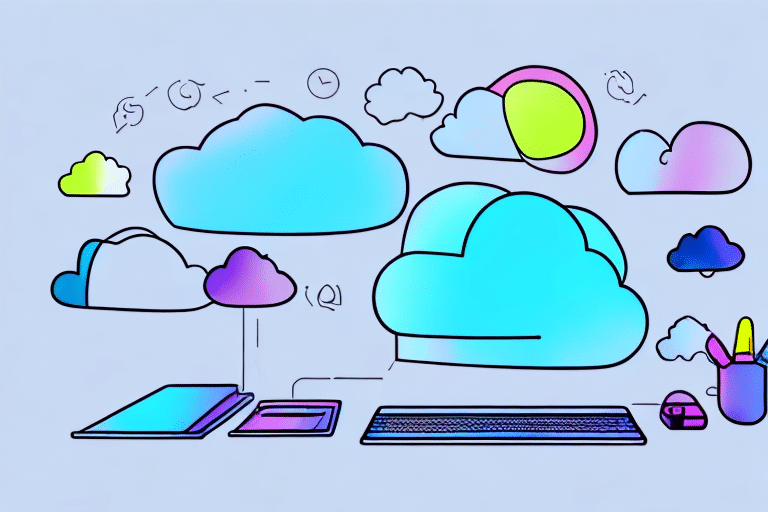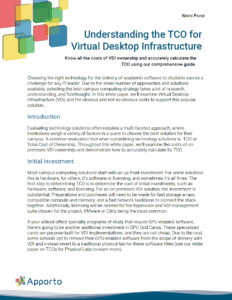In today’s rapidly advancing digital landscape, the traditional concept of a physical workspace is undergoing a significant transformation. The rise of remote work and the need for flexible, scalable solutions has led to the emergence of Virtual Desktop Infrastructure (VDI) as a game-changing technology.
Understanding Virtual Desktop Infrastructure (VDI)
Before delving into the revolution VDI is bringing to workspaces, it is essential to have a clear understanding of what VDI is and its core components.
Virtual Desktop Infrastructure (VDI) is a virtualization technology that enables users to access a complete desktop environment hosted on a remote server, rather than on their local machine. This means that users can access their desktop, applications, and data from any device with an internet connection. VDI provides a flexible and secure solution for organizations, allowing employees to work remotely while maintaining the same level of productivity.
The core components of VDI include the hypervisor, connection broker, virtualization infrastructure, and user desktops. The hypervisor is responsible for creating and managing the virtual machines that host the user desktops. The connection broker acts as a middleman, connecting users to their virtual desktops and managing the allocation of resources. The virtualization infrastructure consists of the servers, storage, and networking components that support the VDI environment. Finally, the user desktops are the virtual machines that provide the desktop experience to the end-users.
The Evolution of VDI Technology
The journey of VDI technology began with the emergence of server virtualization, which allowed for the consolidation of multiple virtual servers onto a single physical server. This breakthrough in virtualization paved the way for more efficient use of resources and cost savings for organizations.
As the technology evolved, companies realized the potential to extend virtualization to desktop environments, giving birth to VDI. The initial implementations of VDI faced challenges such as limited hardware capabilities and network bandwidth, which affected the user experience. However, with advancements in hardware virtualization, multimedia redirection, and protocol optimizations, VDI technology has made significant strides.
Hardware virtualization technologies, such as Intel VT-x and AMD-V, have improved the performance and efficiency of virtual machines, enabling them to run seamlessly on the server hardware. Multimedia redirection allows for the offloading of multimedia processing to the client device, reducing the strain on the server and improving the playback of audio and video content. Protocol optimizations, such as Citrix HDX and VMware Blast, have enhanced the delivery of virtual desktops over the network, providing a smooth and responsive user experience.
VDI technology has also benefited from advancements in storage and networking technologies. The introduction of solid-state drives (SSDs) has significantly improved the performance of virtual desktops, reducing boot times and improving application responsiveness. Network technologies, such as 10 Gigabit Ethernet and WAN optimization, have increased the bandwidth and reduced latency, enabling users to access their virtual desktops from remote locations without compromising performance.
Overall, VDI technology has come a long way since its inception. It has witnessed remarkable advancements that have addressed the initial challenges and limitations, resulting in improved user experiences and enhanced performance. As organizations continue to embrace remote work and the need for flexible workspaces, VDI is poised to play a crucial role in shaping the future of work.
The Role of VDI in the Future of Workspaces
VDI, or Virtual Desktop Infrastructure, is poised to play a critical role in shaping the future of workspaces, catering to the increasing demand for remote work capabilities and providing organizations with the necessary scalability and flexibility to adapt to changing business needs.
Enhancing Remote Work Capabilities
With the rise of remote work, organizations are looking for ways to empower their employees to work from anywhere, at any time. VDI enables seamless remote access to a user’s virtual desktop, ensuring that employees have a consistent experience regardless of their location.
Imagine a scenario where an employee is traveling for a business meeting. With VDI, they can easily access their virtual desktop from their hotel room, ensuring that they have all the necessary files and applications at their fingertips. This not only saves time but also enhances productivity and efficiency.
Additionally, VDI allows for secure data access and collaboration, minimizing the risks associated with data loss and unauthorized access. It provides employees with a secure gateway to their virtual desktops, ensuring that sensitive information remains protected. This is especially crucial in industries that deal with sensitive customer data or proprietary information.
Promoting Scalability and Flexibility
Another key advantage of VDI is its ability to scale rapidly and accommodate changing work demands. As organizations grow or undergo restructuring, VDI allows IT administrators to provision new desktops or reassign resources with ease.
Imagine a scenario where a company acquires a new subsidiary. With VDI, the IT team can quickly set up virtual desktops for the new employees, ensuring a smooth transition and minimizing disruption. This scalability also extends to seasonal or temporary workers, where additional virtual desktops can be provisioned as needed.
Moreover, VDI offers flexibility in terms of device compatibility. Users can access their virtual desktops from a variety of devices, including laptops, tablets, and even smartphones, allowing for increased productivity and convenience. This means that employees can choose the device that best suits their work style and preferences, without compromising on performance or functionality.
Imagine a scenario where an employee prefers to work on a tablet while commuting. With VDI, they can easily access their virtual desktop and continue their work seamlessly, without the need to transfer files or compromise on the user experience. This flexibility not only enhances employee satisfaction but also enables organizations to attract and retain top talent.
Understanding the TCO for Virtual Desktop Infrastructure
The Benefits of Implementing VDI
Implementing Virtual Desktop Infrastructure brings forth a myriad of benefits for organizations of all sizes, transcending beyond just cost efficiency and improved data security.
VDI, also known as desktop virtualization, is a technology that allows organizations to host desktop environments on a centralized server or data center, which can then be accessed by end-users remotely. This innovative approach to desktop management has revolutionized the way organizations operate, offering numerous advantages that go beyond the surface.
Cost Efficiency and Reduced Hardware Dependency
One of the key benefits of VDI is its ability to reduce hardware dependency. By centralizing desktop management and utilizing virtual machines, organizations can significantly lower their IT infrastructure costs. With VDI, there is no longer a need for individual machines incurring regular maintenance and upgrades.
Moreover, VDI simplifies the management of software updates and application deployments. Instead of manually installing updates on multiple individual desktops, updates can be rolled out centrally, ensuring consistency and reducing IT workload. This streamlined approach not only saves time but also minimizes the risk of errors or compatibility issues.
Furthermore, VDI enables organizations to extend the lifespan of their existing hardware. By repurposing older devices as thin clients, organizations can maximize their investment and reduce the need for frequent hardware replacements. This not only reduces costs but also contributes to a more sustainable and environmentally friendly IT infrastructure.
Improved Data Security and Compliance
Data security is a major concern for organizations in today’s digital landscape. VDI offers enhanced data security by keeping sensitive information within the data center, rather than dispersed across individual devices.
With VDI, data is stored and processed centrally, reducing the risk of data breaches or unauthorized access. In the event of a lost or stolen device, sensitive data remains secure as it is not stored locally. This provides organizations with peace of mind, knowing that their critical information is protected and can only be accessed through secure connections.
VDI also allows for stricter access control, making it easier to enforce security policies at a granular level. Administrators can define user permissions and restrict access to specific applications or data based on individual roles or departments. This ensures that sensitive information is only accessible to authorized personnel, minimizing the risk of internal data breaches.
Additionally, by centralizing data storage and backup, organizations can improve disaster recovery capabilities. In the event of a system failure or natural disaster, data can be quickly restored from backups, minimizing downtime and ensuring business continuity. Moreover, VDI can help organizations meet compliance requirements more effectively, as data can be encrypted and access can be audited, providing a robust framework for regulatory compliance.
In conclusion, implementing VDI offers a wide range of benefits for organizations, including cost efficiency, reduced hardware dependency, improved data security, and enhanced compliance. By leveraging this innovative technology, organizations can streamline their IT operations, increase productivity, and achieve a more secure and resilient IT infrastructure.
Overcoming Challenges in VDI Adoption
While the benefits of VDI are compelling, organizations may face certain challenges during the adoption process. Addressing these challenges is crucial to ensuring a successful implementation and user acceptance.
Addressing Technical Limitations
VDI implementations historically faced challenges related to network bandwidth, storage requirements, and application compatibility. However, advancements in technology have significantly mitigated these limitations.
Companies must thoroughly assess their infrastructure capabilities and invest in robust network infrastructure to support VDI deployments smoothly. Implementing technologies such as WAN optimization and intelligent caching can further enhance the user experience.
Ensuring User Acceptance and Training
User acceptance is vital for the success of any new technology implementation. It is crucial to involve end-users from the early stages of planning to ensure that their needs are addressed, and any concerns are appropriately mitigated.
Organizations must provide comprehensive training to employees to familiarize them with the VDI environment and its benefits. By providing ongoing support and clear communication, organizations can encourage user adoption and minimize resistance to change.
The Impact of VDI on Different Industries
VDI is not limited to a particular industry; it has the potential to revolutionize workspaces across various sectors. Let’s explore the impact of VDI in healthcare and education.
VDI in Healthcare: Streamlining Patient Care
In the healthcare industry, VDI facilitates secure access to patient information, enabling healthcare professionals to deliver timely and efficient care. The ability to access patient records remotely ensures that healthcare providers have the necessary information at their fingertips, even when they are not physically present at the healthcare facility.
Moreover, VDI’s centralized management and security features help healthcare organizations meet stringent regulatory requirements, such as HIPAA compliance.
VDI in Education: Facilitating Remote Learning
Education institutions can leverage VDI to enable remote learning and bring education to students wherever they are. VDI allows students to access their virtual desktops and course materials from any location, promoting inclusivity and flexibility.
Additionally, VDI provides educators with control over the learning environment, ensuring that students have access to the necessary resources while maintaining security and minimizing distractions.
As we step into the future, it is evident that VDI is revolutionizing workspaces by offering enhanced remote work capabilities, scalability, and flexibility. The benefits of implementing VDI, such as cost efficiency, improved data security, and compliance, make it an attractive option for organizations across industries. However, successful VDI adoption requires overcoming technical limitations, ensuring user acceptance through effective training and addressing industry-specific challenges. Embracing VDI can pave the way for a more connected, efficient, and productive future of workspaces.



